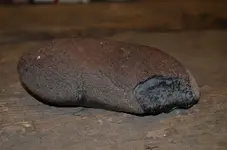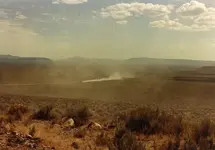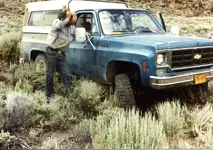BosnMate
Gold Member
- Joined
- Sep 10, 2010
- Messages
- 6,916
- Reaction score
- 8,441
- Golden Thread
- 0
- Detector(s) used
- Whites MXT, Whites DFX, Whites 6000 Di Pro
- Primary Interest:
- Other
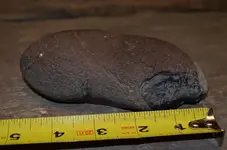 The rock to the left was found out in south central Oregon. We were driving to the ghost town of Blitzen, heading out across a huge flat. At that time out on the desert fences were rare, they might be a little more common now, but I had to stop and open a rare gate, then when closing the gate, I was looking at the various rocks laying about. There was the usual lava rock, and in amongst that were these rounded rocks. Fifteen thousand years ago where I was standing was a lake. When the ice age melted, the water that flowed east had no outlet, and parts of Oregon and Nevada were under the waters of Lake Lahonton. I suppose these rocks blew out of a volcano like Glass Butte, and landed in the lake in order to be formed into this cobble shape, because they were all located a long way form running water at any time in the past, so they aren't creek cobbles. So I picked one up, and when it was turned over, someone had purposely knocked spalls off or it, or perhaps preforms for making a point. Anyhow it's obviously obsidian, of the same type that is on Wagontire mountain. The next photo shows where the spalls were knocked off, which is the reason I kept it and brought it home.
The rock to the left was found out in south central Oregon. We were driving to the ghost town of Blitzen, heading out across a huge flat. At that time out on the desert fences were rare, they might be a little more common now, but I had to stop and open a rare gate, then when closing the gate, I was looking at the various rocks laying about. There was the usual lava rock, and in amongst that were these rounded rocks. Fifteen thousand years ago where I was standing was a lake. When the ice age melted, the water that flowed east had no outlet, and parts of Oregon and Nevada were under the waters of Lake Lahonton. I suppose these rocks blew out of a volcano like Glass Butte, and landed in the lake in order to be formed into this cobble shape, because they were all located a long way form running water at any time in the past, so they aren't creek cobbles. So I picked one up, and when it was turned over, someone had purposely knocked spalls off or it, or perhaps preforms for making a point. Anyhow it's obviously obsidian, of the same type that is on Wagontire mountain. The next photo shows where the spalls were knocked off, which is the reason I kept it and brought it home. 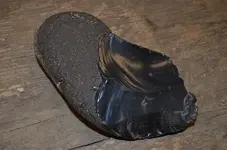 Because Gets The Point identified my large bi-face from the Roseburg apartment construction,
Because Gets The Point identified my large bi-face from the Roseburg apartment construction, 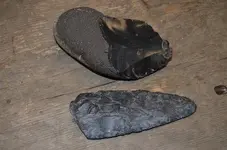 as being basalt, I decided to take a photo of them side by side. It's obvious that the blade is not obsidian. So I decided to put this rock between two pieces for obsidian that I picked up on Glass Butte out of the area of obsidian that I showed in a previous post.
as being basalt, I decided to take a photo of them side by side. It's obvious that the blade is not obsidian. So I decided to put this rock between two pieces for obsidian that I picked up on Glass Butte out of the area of obsidian that I showed in a previous post. 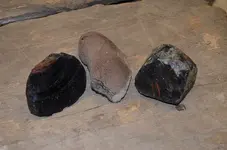
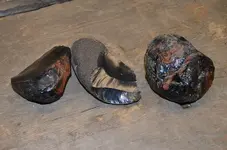 The stones from Glass Butte have a bit of red, or mahogany color in them, and the difference in the two stones is pretty subtle, but eyeballing there is a difference. Anyhow I thought this was interesting enough to post, hope you guys agree with me.
The stones from Glass Butte have a bit of red, or mahogany color in them, and the difference in the two stones is pretty subtle, but eyeballing there is a difference. Anyhow I thought this was interesting enough to post, hope you guys agree with me.Attachments
Upvote
0



